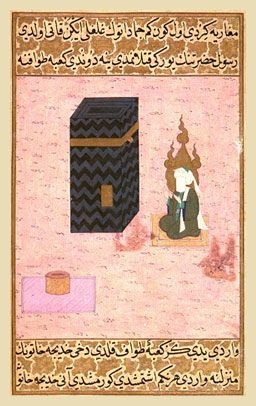
Like other pre-Axial societies, pre-Islamic Arab beliefs involved a pantheon of accessible deities with whom people could communicate. They also believed in darh or fate which probably helped them adapt to the high mortality rate. Above all of the lesser Gods was the one remote God, al-Lah –the God who was the same God worshipped by the Jews and Christians. He was beyond the reach of ordinary people. Lesser deities were represented in the Ka’ba and in shrines to their individual honor scattered throughout the peninsula. These gods would be prayed to for rain, children, health and the like and would intercede on their behalf to Allah – the God in times of dire need.
This pre-Islamic attitude towards religion provided a framework that was open to ideas and interpretations. The Sasanian presence in the Arabian Peninsula had brought with it the influence of Zoroastrianism, in which Ahura Mazda and Ahriman, the Gods of Light and Darkness, were in constant battle for the souls of humanity. Jewish presence in the area dates possibly from as early as the Babylonian Exile in 597 BCE and certainly from the time of the Great Revolt in AD 70, almost six centuries before Mohammad. Scholars note that a symbiotic relationship existed between the two peoples: Jews were Arabized and Arabic speaking and over the centuries Arabs had absorbed Jewish beliefs and practices. There were Jewish merchants and Jewish Bedouin, farmers, poets and warriors. What today is the center of Islam, the Ka’ba in Mecca, has ancient Semitic roots: Adam, Noah, Abraham, Moses and others were associated with it long before the rise of Islam. Both Jews and Arabs were believed to be descendants of Abraham, an idol of whom could be viewed inside the pre-Islamic Ka’ba.
Since their earliest times Christian groups were established in Syria and Mesopotamia. In AD 313, the Emperor Constantine made Christianity legal and it became accepted as the imperial religion by Rome. The First Council of Nicaea in AD 325, declared Christ to be both fully God and fully man and established belief in the Trinity which represented God as three in one: the Father, Son and Holy Spirit. Those who disagreed with this new orthodox position, Nestorians, Gnostics, and Arians for example, were excommunicated and declared heretics. Many fled from persecution, beyond the reach of the Byzantine Empire into the Persian and Arab worlds. Theirs was a proselytizing faith and as they spread throughout the Peninsula a number of tribes were converted. The Ghassanids, who wintered on the border of Byzantium, became the largest early Christian tribal community, the Nabateans another, and by the sixth century the Yemenite city of Najran was a center of Arab Christianity.
The distance from both empires enabled beliefs in the Arab Peninsula to evolve and flourish independently, especially in Mecca. According to Fred M. Donner, Professor of Near Eastern History at the University of Chicago, by the sixth century paganism was receding in the face of the gradual spread of monotheism. Hanifism arose in Mecca and spread throughout the Hijaz. Its members “turned away from” idolatry, seeking to follow the original, essential monotheism of Abraham, before the establishment of either Judaism or Christianity.
Prophets and spiritual Teachers are not born in a vacuum. The influences and practices of contemporary and historical thinkers and prophets fuel their reactions to the world around them. Jesus, for example, was likely influenced by the theological and ethical teachings of Jeremiah and Hillel, the latter died in his youth and both prophets’ views were at the time, well known in the area. In Hanifism we find a key to Mohammad’s prophetic inspiration. To quote Barnaby Rogerson again: “As Muhammad grew in wealth and wisdom he joined a select group of thinkers in Mecca known as the hanif, the seekers. The hanif searched for a coherent religious identity for the Arabs, a clear doctrine to replace the welter of deities and the shambles of blood sacrifices held around the temple at Mecca. They focused their attention on the all-encompassing father god Allah whom they freely equated with the Jewish Yahweh and the Christian Jehovah.”
The Hanifs regularly spent some of their time away from the polytheist environment and made retreats to nearby hills to meditate, contemplate and pray, as did Mohammad. One such hill was Hira’ the location where Mohammad would receive what is known as his first revelation. Hanifs, in common with the directives given in the Qu’ran, worshipped only the one God, who required commitment to a moral code: believers had to strive to be morally upright, mindful of an afterlife when one’s choices would be judged.
The Qur’an has several entries that mention Hanif, for example: 22:31 Be hanif in religion towards Allah, and never assigning partners to Him: if anyone assigns partners to Allah, it is as if he had fallen from heaven and been snatched up by birds, or the wind had thrown him into a distant place.



